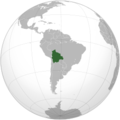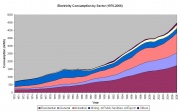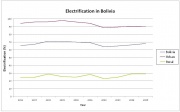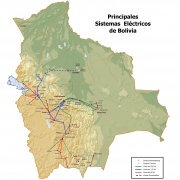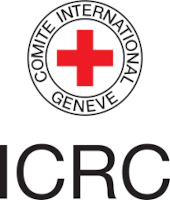Knowledge fuels change
For over a decade, Energypedia has shared free, reliable energy expertise with the world.
We’re now facing a serious funding gap.
Help keep this platform alive — your donation, big or small, truly matters!
Thank you for your support
Bolivia Energy Situation
Capital:
Sucre
Region:
Coordinates:
16.7120° S, 64.6660° W
Total Area (km²): It includes a country's total area, including areas under inland bodies of water and some coastal waterways.
XML error: Mismatched tag at line 6.
Population: It is based on the de facto definition of population, which counts all residents regardless of legal status or citizenship--except for refugees not permanently settled in the country of asylum, who are generally considered part of the population of their country of origin.
XML error: Mismatched tag at line 6. ()
Rural Population (% of total population): It refers to people living in rural areas as defined by national statistical offices. It is calculated as the difference between total population and urban population.
XML error: Mismatched tag at line 6. ()
GDP (current US$): It is the sum of gross value added by all resident producers in the economy plus any product taxes and minus any subsidies not included in the value of the products. It is calculated without making deductions for depreciation of fabricated assets or for depletion and degradation of natural resources.
XML error: Mismatched tag at line 6.2 ()
GDP Per Capita (current US$): It is gross domestic product divided by midyear population
XML error: Mismatched tag at line 6. ()
Access to Electricity (% of population): It is the percentage of population with access to electricity.
XML error: Mismatched tag at line 6.no data
Energy Imports Net (% of energy use): It is estimated as energy use less production, both measured in oil equivalents. A negative value indicates that the country is a net exporter. Energy use refers to use of primary energy before transformation to other end-use fuels, which is equal to indigenous production plus imports and stock changes, minus exports and fuels supplied to ships and aircraft engaged in international transport.
XML error: Mismatched tag at line 6.no data
Fossil Fuel Energy Consumption (% of total): It comprises coal, oil, petroleum, and natural gas products.
XML error: Mismatched tag at line 6.no data
Introduction
Bolivia, with a population of approximately 10.4 million inhabitants, is considered one of the poorest countries in Latin America. While urban areas such as La Paz and Santa Cruz are modern cities with a relatively good supply of modern energy services, the majority of Bolivia’s rural areas are still experiencing a lack of most basic services, including reliable and affordable access to electricity and improved biomass cooking stoves. Thus, in 2007, total access to electricity in Bolivia was 80.2%. Urban access was 98.2%, while rural access remained as low as 46.6%. Through the last years, and especially since 2005 when EnDev started working, modern electricity access has improved in Bolivia. In 2005 it was estimated that only 33% of the rural population had access to electricity; situation that had improved till 2011 where it is estimated that this figure is around 53%.
Bolivia is a significant exporter of hydrocarbons, especially natural gas. Due to low levels of investment in the electricity, and oil and gas sectors, energy supply has started to be a concern. Limited gas availability might delay necessary investments in thermo-generation. Additionally, low levels of investment in the oil sector may result in shortages in the supply of diesel oil, liquefied petroleum gas (LPG) and other oil derivatives. This situation might have an adverse effect on Bolivia’s ability to meet export commitments to Argentina and Brazil. Due to the absence of refineries Bolivia has to import refined petroleum products as well.
Electricity is nearly exclusively generated by private companies from hydropower (36,3%) and thermal power plants mainly based on gas (59,7%). The total installed capacity is 1645 MW (Balance energético nacional 2000-2010), the installed capacity connected to the National Grid System (SIN) in 2011 was 1,31 GW (Memoria CNDC 2011) and the contribution of other renewable sources than hydropower is almost negligible. 85% of the electricity were produced in the Sistema Interconectado Nacional (SIN - National Grid System), while 15% were produced in isolated systems (mainly diesel-driven generators). The demand for electricity rose in the last 20 years dramatically and led into a series of outages and unsatisfied demand. There was a significant rise in the household sector.
Energy Situation
[Show/hide]
Rural electrification
Bolivia has one of the lowest rural electrification rates of Latin America. Urban access is estimated to be 98%, rural access is estimated to be 50%.[1]Traditional biomass (wood, dung, charcoal and green residue) still accounts for 16% of primary energy production and 16,4% of final energy consumption. It is therefore the third most important source of energy after natural gas and petroleum (derivates). This is mainly due to the important role of biomass for the energy supply in the country’s rural areas. In 2007, 70,1% of rural households was still using biomass (firewood or dung) as fuel for cooking (INE 2010).
Electricity Situation
[Show/hide]
Like in other countries, Bolivia’s electricity sector consists of the National Interconnected System (SIN) and off-grid systems (known as the "Aislados"). The Bolivian electricity market is strictly divided into three fields: generation, transmission, distribution. One company is not allowed to work in more than one of this fields. However there is an exception for off-grid systems. Most of the electricity companies have been nationalized.
Power Generation
In 2011 some 6,611 GWh were generated in the national grid. Currently, there are eight generation companies in the interconnected system. The three largest companies alone represent 70% of the total generation. The largest company serving the SIN is the Compañia Boliviana de Energía Eléctrica (COBEE), which serves the region surrounding La Paz. Furthermore COBEE is the only company, which has both thermoelectric power plants and hydroelectric ones. The other two bigger companies are Empresa Eléctrica Guarachi (EGSA; thermal) and Empresa Eléctrica Corani (CORANI; hydropower).Transmission
All mayor cities -except Tarija and Trinidad- are connected to the national grid. A line to connect Tarija is under construction.
Currently, there are two transmission companies in the SIN, Transportadora de Electricidad (TDE), formerly owned by Spain’s Red Eléctrica de España (REE) and recently nationalized, and ISA Bolivia, which was created in 2005. ISA Bolivia, which runs 53% of the transmission network in Bolivia, is a subsidiary of Interconexión Eléctrica S.A. (ISA), a corporation controlled by the government of Colombia. The number of companies is limited due to the existence of institutional entry barriers in this sector.
Distribution
In Bolivia, the seven existing distribution companies enjoy a geographic monopoly in their concession areas. The largest company (in terms of kWh sold) is Electropaz, majority-owned by Spain’s Iberdrola. The second place is occupied by the Empresa de Luz y Fuerza Eléctrica Cochabamba (ELFEC), which was owned by the American PPL Global until 2007, ; followed by the Rural Electrification Cooperative (CRE), which operates in the Department of Santa Cruz.[2]
Off-grid and self-supplying systems
The departments of Beni, Pando and Tarija and the eastern region of Santa Cruz are not integrated in the SIN. As a result, there are vertically integrated operators that provide the service. The most important operators are:
- SETAR (Servicios Eléctricos Tarija, S.A.): 44 MW, serves 56,885 clients
- ENDE (Empresa Nacional de Electricidad): 16.65 MW, serves 16,650 clients
- CRE (Cooperativa Regional de Electricidad): 14.53 MW, serves 4,940 clients.
In some cases, especially in the high plateau, cooperatives and community organizations access the distribution companies’ network and sell electricity to small rural communities. Sometimes, those are organized enterprises that provide the service to middle-size towns, but in most cases, they are small organisations that serve family communities. This situation faces a legal vacuum since the consumers benefiting from these scheme, who do not consume the minimum power legally established, cannot be considered as regulated ones. In addition, these consumers are localized outside the distribution companies’ concession areas, so they cannot receive the companies’ service. In practice, the distribution companies are reselling electricity to the mentioned organizations outside the legal framework. Accurate information on the number of organizations that operate in rural areas does not exist. However, there are approximately three in La Paz, twenty in Oruro and three in Potosi.
Obstacles for Off-grid Energy Technologies and Services
Despite great efforts of the government and foreign donors to improve access to electricity, the majority of the rural poor lacks access to modern energy for lighting, communication etc. Close to 70% of the population have to rely on biomass for their energy needs. Especially wood and other traditional biomass is widely used for cooking in a very inefficient manner. This issue needs to be tackled urgently since biomass has become scarce in some arid areas. Furthermore, indoor air pollution, resulting from traditional combustion technologies and practices, is causing severe health problems, especially among women and children. Moreover, extensive use of wood for cooking is resulting in deforestation and related environmental problems - since forests are often not managed in a sustainable manner. In addition, most schools and health facilities in rural areas are suffering from a lack of hot water, adequate cooking conditions and means to heat their premises. The responsible municipalities are able to cater to the regular budgets; but they have great deficiencies in channeling their increased financial resources into energy related investments. Their human and institutional capacity to improve access to modern energy for households and community-run social infrastructure institutions is very low.
In nearly all national and municipal support programmes for the productive sector, energy related issues such as technology or reliable energy supply are missing. This hampers in many cases the development of better processing facilities and value added products in rural areas.
Policy Framework, Laws and Regulations
[Show/hide]
Poverty Reduction Strategy
Bolivia is one of the poorest countries in Latin America and has one of its highest levels of inequality. The reduction in poverty rates experienced in the 1990s when Bolivia had modest but consistent growth rates was reversed by external and internal shocks at the end of the millennium. The per capita Gross National Income (GNI) amounted to US$1,699.5 in 2009(*), and the United Nations Development Program (UNDP) ranked Bolivia 108th (out of 187 countries) on its Human Development Index.
An Interim Strategy Note was signed by the Bolivian Government and the Worldbank in 2009. The mayor focus is on equity. With respect to the energy sector the paper focusses on the development and exploitation of the hydrocarbon resources. The Decentralized Infrastructure for Rural Transformation (US$20 million), which provided alternative energy mechanisms (solar panels) to remote areas, and might help reduce, although not significantly, pressures on energy demand. Depending on performance and Government priorities, a second phase of the programme will be considered.
Energy Policy
The Bolivian government’s efforts to improve delivery of energy services to the poor have been quite intensive in recent years. First, the broad energy sector reform programme that comprised among others the privatisation of state utilities, was implemented in the mid-1990s. The reform improved the overall performance of the electricity sector and achieved important coverage gains in urban areas, connecting and providing access to the grid for about 98% of the urban population. The access rate in rural areas, however, has grown from 13.7% in 1997 to 46,6% in 2010.
In 2002, the government of Bolivia developed an ambitious rural electrification plan (PLABER – Plan Bolivia de Electrificación Rural) to increase access to electricity in rural areas from 25% to 45% within five years. However, implementation of the plan has been slow due to the ongoing political and economic crisis.
In the National Development Plan 2006 - 2010, electric energy is defined as a strategic sector with four general policies:
- Development of electric infrastructure in order to comply with national necessities and the generation of excess for export
- Increased coverage in rural and urban areas, making the service universal
- Energetic Sovereignty and Independence
- Consolidation of the State in the development of the electric industry with sovereignty and social equity
Within the National Development Plan grid densification is explicitly mentioned.
The World Bank financed Decentralized Infrastructure for Rural Transformation Project (US$20 million) was supporting the Government’s effort to improve the delivery of electricity services in rural areas of the country. More specifically, the project was supporting rural converge expansion through Solar Photovoltaic Systems, grid extension to consumers that are close to the grid (densification) and other forms of energy and Information and Communication Technologies (ICT) Investments.
Laws
In the new constitution from 2009, the universal access to services such as electricity is a fundamental right. (Art.20).
The Electricity Law (Ley de Electricidad) establishes the electricity policy in Bolivia. Article 5 defines that the use of water and other renewable resources has to be multiple, rational, integral and sustainable. To ensure this the government can define a minimum share for hydropower in the total production capacity. Furthermore the responsibilities of the public actors and the institutional set up.
In 2006 a new Law for Universal Access to Electricity (Ley de Acceso Universal) was proposed. Under the framework of this Law, the program called ‘Electricity for a Decent Living” has been designed to improve both rural and urban electrification. The short term goal (2006-2010) of the program was to increase rural electrification to 53% (connection of 210,000 new households) and urban electrification to 97% (connection of 460,000 new households). The medium term goal (2010-2015) is to achieve universal access in urban areas and a 70% access in rural ones. In the final stages, rural access would have increased to 87% by 2020 and universal coverage would be reached by 2025. The Law also mandates the creation of a Common Fund for Universal Access to Public Electricity Sevice (FOCO) and creates a co-financing mechanism of the National Government with Prefectures, municipalities and the private sector. However, the Law has not been approved yet, although it is expected that the Law and the mechanisms it creates will be approved soon.
A new Rural Electrification Decree was approved in 2005 (Supreme Decree No. 28567). This new decree aims at increasing rural access through the extension and densification of electric networks, development of renewable energy and a change in the energy mix (substitution of diesel by natural gas, biomass and other renewable energies) and an increase in distribution capacity. The Rural Electrification Decree and its associated regulatory framework encourages stakeholders in the energy sector to establish partnerships with other government agencies to implement the rural electrification plan. An agreement between the Ministry of Public Works, Services and Housing and the Ministry of Education allowed the installation of solar PV systems in rural areas in conjunction with the literacy program, “I can” (Yo sí Puedo).
Institutional Set-up and Actors in the Energy Sector
[Show/hide]
Public Institutions
The Viceministry of Electricity and Alternative Energy (VMEEA), within the Ministry of Petroleum and Energy (MHE), is in charge of establishing policies and designing the regulation for the electricity sector. The VMEEA and the Viceministry of Energy Development (VMDE) are in charge to develop policies to promote energy efficiency and renewable energy. A Working group of VMDE and VMEEA, the "Energy Development Unit", develops the National Plan for Rural Electrification.
Energy Authority (AE) (known before as the Superintendencia de Electricidad (SE) is responsible for applying the regulation set by the VMEEA and it grants and supervises concessions. It controls the Comité Nacional de Despacho de Carga (CNDC), which is the entity responsible for the operation of the Interconnected Electric System (SIN), the management of the Wholesaler Electric Market (MEM) of Bolivia and of the Planning of the Expansion of the SIN following the guidelines of the Ministry of Hydrocarbons and Energy.The CNDC consists of delegates of the relevant companies.
The electricity sector in Bolivia was privatized in the early 1990s and was unbundled into generation, transmission and distribution. Like in other countries, Bolivia‘s electricity sector consists of the National Interconnected System (SIN) and a number of off-grid systems (known as the "Aislados"). Other donors within the programme ―Electricity for a life in Dignity‖ are KfW, UNDP (small hydropower), World Bank (grid extension, Solar Home Systems), and the EU (community solar and wind hybrids). Also, EnDev cooperates with the World Bank regarding improved stoves and Pico PV. EnDev will continue to work with governmental institutions on all levels: National, prefectural and municipal, as well as with cooperatives, NGOs and the private sector. Improved stoves will also be part of the National Watershed Plan. The counterparts for Biogas plants, small irrigation and product transformation (energy for productive use) usually are entire communities or cooperatives. The connection of social infrastructure to the natural gas grid has been declared national policy by the Ministry for Energy and Hydrocarbons in 2006, while photovoltaic and thermal hot water systems usually are implemented together with municipalities. EnDev applies the subsidiarity principle according to the need of the partners and structures and the characteristics of the technology. For example, while strengthening the capacities for improved stove dissemination on the community level, municipal and national partners are also being involved. Grid densification usually works with national, prefectural and municipal governments and the private sector (utilities), complementing with training for electricians on the community level.
ENDE (Empresa Nacional de Electricidad):The national electricity enterprise is in charge of the execution of Electric and energy policies. Now it is in charge also of the nationalized enterprises as subsidiaries of the main office. ENDE is in charge of the wind energy studies where the German cooperation is also giving advice, with CINERꞋs experts.
Other Major Activities in the Country
- DGIS is supporting the National Gas and Petroleum holding YPFB in its restructuring process,
- DGIS financed the NGOs Energetica and ETC to provide complementary technical assistance as well as awareness campaigns to the Cochabamba regional government,
- KfW is financing a small hydroelectric programme which is currently being revised,
- The BMZ has been asked by the Bolivian Government to support the development of wind energy,
Non Governmental Service Providers for Rural Areas in the Field of Energy
Projects implementing NGOs:
- Centro de Promoción de Tecnologías Sostenibles (CPTS), La Paz
- Centro de Información en Energías Renovables (CINER) seeks to contribute to the conservation of natural resources through the rational use of energy. Thereby orienting, assessing, and promoting the exchange of information, investigation, and techonology between institutions, enterprises, and people that work in the field of energy, stimulating a relationship between the use and production of energy. CINER is also a CIM-partner.
- Energética is a Bolivian NGO which gives technical assistance for the end users, micro-enterprises, government offices and other institutions in many issues like the energy planning, design, execution and evaluation of energy projects, etc. .
- Cedesol is a Foundation that provides creative market practices to enable the people of Bolivia, regardless of their economic standing, to be able to acquire an ecological stove.
- Consejo Empresarial para el Desarrollo Sostenible (CEDES) works generally on sustainable development and has as well projects on ICS .
- PROLEÑA - BOLIVIA is a sister organisation of the Nicaraguan NGO PROLEÑA and used to work on improved stoves as well.
- Sobre la Roca - Energías Alternativas is a partner organisation of CEDESOL. It focusses on solar cooking and improved stoves.
- Tecnologías en Desarrollo a non for profit organisation created in 2000 to promote the use of appropriate technology, focusing particularly on biogas.
- Practical Action is a non for profit organization, with the main house in England and an office for Andean region in Peru.
Commercial service provider:
Biogas:
- Bravotec, Santa Cruz.
Solar:
- Batebol: Batteries for solar appliance
- Enersol, Santa Cruz: PV for rural, commercial or refrigeration appliance and solar pumping.
- Eco Sol, Cochabamba: Solar collectors
- Phocos: Bolivian subsidiary; PV and Micro-Hydro
- Pro Sol, Cochabamba: PV
- RC Limitada, Santa Cruz: PV and Wind Energy.
Micro-Hydropower:
- Alternative Energy Systems (AES)
- Phocos: Bolivian subsidiary; PV and Micro-Hydro
- Ecotecnologías Energéticas y Productivas (ECOTEC), La Paz
Wind Energy:
- RC Limitada, Santa Cruz: PV and Wind Energy.
Micro-Finance Institutions: The micro-finance sector in Bolivia is well developed. The Fondo de Desarrollo del Sistema Financiero (FONDESIF) as a public institution is responsible for the development of this sector. There are a lot of other institutions. Among them the most important are:
- Prodem is the oldest private micro-finance institute. It has subsidiaries in all the Departments of Bolivia.
- Banco Solidario (BancoSol) is the biggest private micro-finance institution in Bolivia.
- FIE is another important private micro-finance institute. It is specialised in micro-entrepreneurs.
- Banco Los Andes ProCredit is the forth private institute, which grants credits to micro- and small entrepreneurs.
- Fundación para la Producción (FUNDA-PRÓ) gives micro-credits to small entrepreneurs using biomass.
- Fondo de Desarrollo Comunal (FONDECO) is specialised in financial services in rural areas.
- Banco de Desarrollo Productivo (BDP) is the country's largest securitization specialist and has approximately 80% of the local market for bond financing. BDP began operations in 1996 as a second-floor financial institution. BDP is indirectly owned by the Andean Development Corporation (CAF) and the Bolivian state.
Further Information
[Show/hide]
- EnDev-Bolivia
- Analysis of the potential to foster electricity and lighting access in the Andean region, thanks to carbon mechanism - Microsol and Rexel Foundation, study led from June 2013 to May 2014. The study provides an overview of access to electricity and lighting in Colombia, Ecuador, Peru, Bolivia and Chile.
References
[Show/hide]


